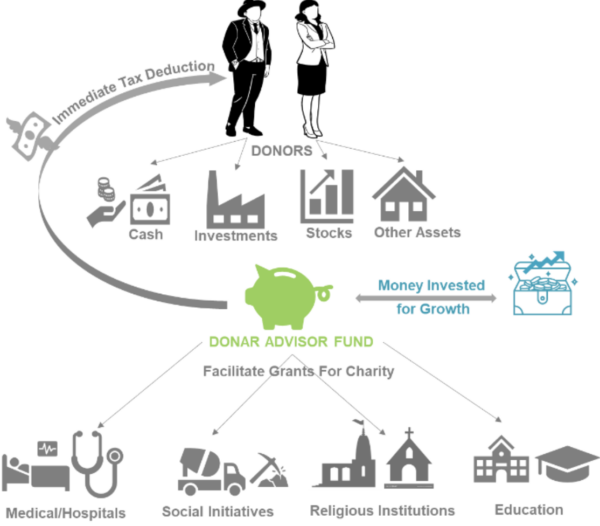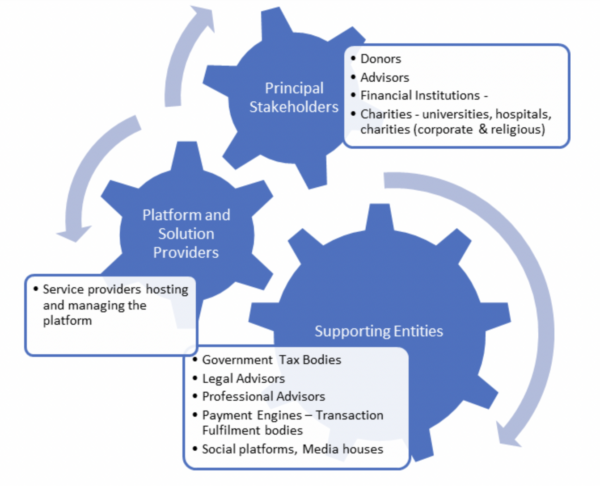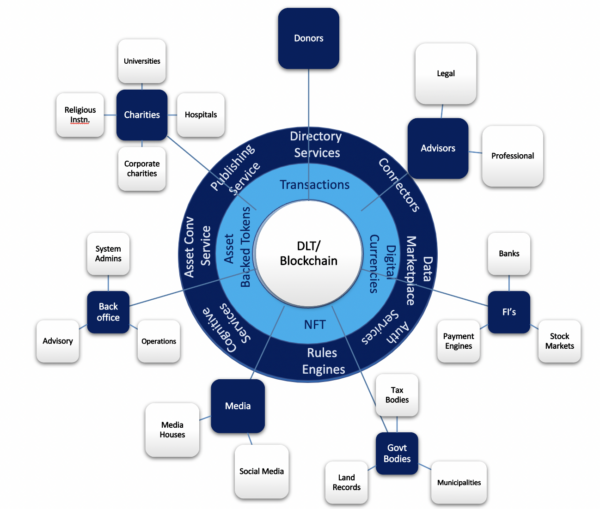
The Future of Philanthropy: Donor-Advised Funds and Metaverse

Philanthropy has existed for centuries across different geographies and cultures. Ancient philanthropy was the prerogative of the rich and the rulers. It revolved around donations for larger causes like building places of worship. Generation after generation, the forms of these initiatives and the way they were facilitated changed.
In the Modern Era (1800 AD to present) traditional philanthropy was aimed at short-term initiatives, where organizations obtain resources for causes through fundraising and one-off donations. The Rockefeller Foundation and the Ford Foundation are examples; they focus more on the financial contributions to social causes and less on the actual actions and processes of benevolence.
In more recent years, the philanthropic focus has shifted to impact investing: the process of allocating money to companies, organizations, and funds with the intention to generate a beneficial social or environmental impact and financial return. While many financing vehicles are likely to be explored by affluent families and high net worth individuals, donor-advised funds (DAFs) provide a critical vehicle for philanthropists.
A DAF is a giving account established for a public charity. It allows donors to make a charitable contribution, receive an immediate tax deduction, and then recommend grants from the fund over a period time for charitable purposes.
- Donor-advised funds are non-profit private funds for philanthropy with an intent of democratization of philanthropy and provide tax benefits to the donor
- They accept and aggregate contributions from multiple donors. This includes cash as low as $5,000 and non-cash assets, such as stocks, bonds, and mutual funds, as well as complex assets like private and corporation stock
The Process
Contribute assets
- To establish a donor-advised fund, the donor makes an irrevocable philanthropic contribution of personal assets, which could include cash, stock, real estate, and more
- The contribution is recorded as a donation and the balance is reflected in the donor-advised fund account
Receive an immediate tax deduction
- Contributions to DAF accounts are eligible to claim an itemized tax-deductible charitable contribution
Diagram
- Description automatically generated with medium confidence

Personalize DAF account
- DAFs typically allows donors to structure ways that best meet your charitable goals
- It allows donors to appoint friends and family members to help donor manage the responsibilities of a DAF; and design a legacy plan to determine what will be done with the DAF assets beyond the donor’s lifetime, which may include appointing successors or charitable beneficiaries
Invest DAF assets for growth
- DAF accounts can be recommended as an investment strategy for the assets by selecting an allocation from among the pre-approved investment offerings
- Any investment growth is tax-free, providing the donor the potential to create even more philanthropic capital for grant-making
Stakeholders

There are 3 important stakeholders in a DAF ecosystem. They can be classified as:
- Primary stakeholders
- Platform and solution providers
- Supporting entities
Board primary entities in the ecosystem are:
- Donors
- Advisors – Legal, professional
- FI’s – Banks, stock markets, payment engines
- Government bodies – Tax bodies, municipalities, land records
- Media – Social media, media houses
- Back office – System admins, operations, advisory
- Charities – Universities, hospitals, corporate charities, religious institutions
Current and Future State Platforms for DAF
Traditionally DAF ecosystem providers develop their systems on top of existing application landscapes on typical centralized hubs and spoke models. The financial institution promoting the fund typically act as the centralized hub and interact with all other entities on its periphery. This resulted in a controlled setup where the promoter of the fund manages the operation and governance of the funds.
With the advent of decentralized computing environments and their ability to provide trust and security of transaction (as in decentralized ledger technologies like blockchain), designing a DAF ecosystem (which has multiple stakeholders) can bring in transaction immutability, transparency, security, faster settlements, and consensus. Thus, trust is built between all the entities.
Here is a proposed solution which will follow the below tenets:
- Transaction immutability: DLT networks inbuilt feature will help build trust within the stakeholders
- Digitize assets that can be traded: In the form of asset-backed tokens, NFT, and digital currencies
- Secure authenticated access: For actors in the network (as explained here) to access the platform through different systems of engagement based on their role and need
- Smart contract enabled templated interfaces: With different agencies to facilitate the transaction fulfillment and convertibility of the traded assets with the real-world assets
- Directory system: To enable actors to refer, access, and transact to different services within the network
- Transparency and rights-enabled publication: The philanthropic contributions of the donors and tracking of the fulfillment of the goals and projects intended to be delivered
- AI-powered communications: Communicate with fundholders, provide AI-powered charity recommendations, customized reports and dashboards, and contextualized live chat customer service via chatbot and in person if needed
- Immersive experience: A platform on metaverse which will provide the actors an immersive experience of their interactions with other stakeholders, the fulfillment of philanthropic endeavors, courtesies, and gratitude of the beneficiaries for the benefit of the donors
How Will it Work?
Donors’ investment are converted into digital assets and stored in DLT (blockchain) against donor’s portfolios.
- Monies to digital currencies, real estate to asset-based tokens/NFT’s, stock investments to tokenized assets

- The valuation of the asset within the ecosystem and their periodic revaluations will be done by connecting to respective asset endpoint viz., digital currencies to the money markets, stock investments to the capital markets, real estate valuation to real-estate marketplaces, etc.
- Tax benefits accrued due to charities will be calculated by the government tax bodies and registered back against donors’ portfolios
Charities register in the platform for accessing philanthropic aid.
- Charities will publish their current field of work, purpose of fund, plans of fund utilization, history of previous fund usage, targeted donors
Financial institutions will help in transaction fulfillment and validation of donor and charities assets. It will provide:
- Accurate financial insights of donor’s assets and financial status of charities, facilitate payment transactions, provide valuation of securities and financial instruments
Government bodies will be accessed for validation of assets and tax related rebates for donors.
- Municipalities will help in validating properties, tokenize properties through NFT’s, and asset-based tokens, help in fulfill property deals
- Tax departments will help in calculating the tax rebates for the monies donated towards charity
Advisors use platform’s back-office operations and its tools to advise donors in allocating their funds against charities. Financial advisors will also recommend investment strategies for donor’s assets.
Platform back office will have all the operational tools for advisors and operators of the platform to recommend and help donors in fulfilling transactions.
- Tools at disposal could be for custodial management, portfolio management, recommendations, fund valuations, reconciliation, transaction fulfillment, reporting, agreement sign-offs, dispute resolutions, etc.
Media outlets will be able to access feeds from the platform to publish donor activities, market news and collect public sentiments
- Publish philanthropic activities to media houses and social media
- Perform sentiment analysis of market feedback and provide the same to the donors to assess the efficacy of philanthropic initiatives
Leverage Metaverse for an Immersive Financial Services Experience
Metaverse has the potential to usher in the social media reach to DAF platforms. It can provide the donors to assess the efficacy of their initiatives as well as the public sentiment of their charitable work. The web3 metaverse, which leverages the blockchain backbone, can very easily be used to develop DAF platforms into DAO (decentralized autonomous organization) wherein smart contracts will govern the rules of the ecosystem and the decision-making is democratized within the stakeholders.
The immersive experience of a virtual world which metaverse offers will allow closer (at times even anonymous) interactions between the donors and the beneficiaries. The ability to directly interact with the larger diaspora will allow for faster and more efficient feedback for philanthropic initiatives. It will also allow periodic monitoring of the projects undertaken visually without the need to travel to the physical site. Donors can create their own virtual worlds within the DAF platform and invite beneficiaries to publish their requests.
Metaverse initiatives on philanthropy have already started with the Alwaleed Philanthropies: a charitable and philanthropic organization in Saudi Arabia launching the first philanthropic platform operating on Decentraland, a well-known metaverse platform running on a Ethereum blockchain backbone.
DAFs for a More Charitable Future
With widening social and economic disparities and the conscience of the world’s wealthiest people to give back to society, instruments like donor-advised funds provide a structured approach to invigorate philanthropic initiatives. The popularity of DAFs has shown dramatic growth in grants, contributions, charitable assets, and number of accounts with grants to qualified charities increasing by 28% to an estimated $45.74 billion.
To take this charitable vehicle to the next level, harnessing the potential of emerging technology solutions like metaverse for DAF can go a long way in popularizing, building operational efficiencies, and delivering outcomes in the most transparent ways as is desired of such philanthropic initiatives.
Apexon is focused on developing innovative solutions for business problems of banking and financial services companies leveraging emerging technology platforms. Our right mix of competencies across different technologies practices like digital engineering, data analytics, and human first digital experiences help in curating solutions for our customers that allow them stay ahead of competition in their digital transformation journeys. Connect with us through the form below.
This blog was cowritten by Arindam Ray, Director of Global Solutions and Bhushan Subhash Bhade, Assistant Manager of Global Solutions




